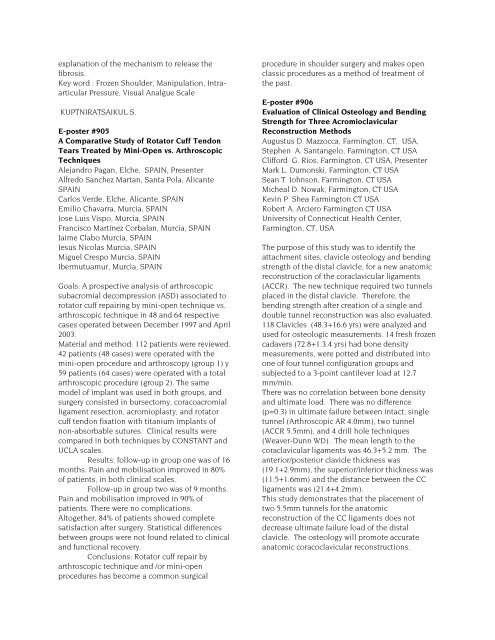POSTER ABSTRACTS - ISAKOS
POSTER ABSTRACTS - ISAKOS
POSTER ABSTRACTS - ISAKOS
Create successful ePaper yourself
Turn your PDF publications into a flip-book with our unique Google optimized e-Paper software.
explanation of the mechanism to release the<br />
fibrosis.<br />
Key word : Frozen Shoulder, Manipulation, Intraarticular<br />
Pressure, Visual Analgue Scale<br />
KUPTNIRATSAIKUL S.<br />
E-poster #905<br />
A Comparative Study of Rotator Cuff Tendon<br />
Tears Treated by Mini-Open vs. Arthroscopic<br />
Techniques<br />
Alejandro Pagan, Elche, SPAIN, Presenter<br />
Alfredo Sanchez Martan, Santa Pola, Alicante<br />
SPAIN<br />
Carlos Verde, Elche, Alicante, SPAIN<br />
Emilio Chavarra, Murcia, SPAIN<br />
Jose Luis Vispo, Murcia, SPAIN<br />
Francisco Martinez Corbalan, Murcia, SPAIN<br />
Jaime Clabo Murcia, SPAIN<br />
Jesus Nicolas Murcia, SPAIN<br />
Miguel Crespo Murcia, SPAIN<br />
Ibermutuamur, Murcia, SPAIN<br />
Goals: A prospective analysis of arthroscopic<br />
subacromial decompression (ASD) associated to<br />
rotator cuff repairing by mini-open technique vs.<br />
arthroscopic technique in 48 and 64 respective<br />
cases operated between December 1997 and April<br />
2003.<br />
Material and method: 112 patients were reviewed.<br />
42 patients (48 cases) were operated with the<br />
mini-open procedure and arthroscopy (group 1) y<br />
59 patients (64 cases) were operated with a total<br />
arthroscopic procedure (group 2). The same<br />
model of implant was used in both groups, and<br />
surgery consisted in bursectomy, coracoacromial<br />
ligament resection, acromioplasty, and rotator<br />
cuff tendon fixation with titanium implants of<br />
non-absorbable sutures. Clinical results were<br />
compared in both techniques by CONSTANT and<br />
UCLA scales.<br />
Results: follow-up in group one was of 16<br />
months. Pain and mobilisation improved in 80%<br />
of patients, in both clinical scales.<br />
Follow-up in group two was of 9 months.<br />
Pain and mobilisation improved in 90% of<br />
patients. There were no complications.<br />
Altogether, 84% of patients showed complete<br />
satisfaction after surgery. Statistical differences<br />
between groups were not found related to clinical<br />
and functional recovery.<br />
Conclusions: Rotator cuff repair by<br />
arthroscopic technique and /or mini-open<br />
procedures has become a common surgical<br />
procedure in shoulder surgery and makes open<br />
classic procedures as a method of treatment of<br />
the past.<br />
E-poster #906<br />
Evaluation of Clinical Osteology and Bending<br />
Strength for Three Acromioclavicular<br />
Reconstruction Methods<br />
Augustus D. Mazzocca, Farmington, CT, USA,<br />
Stephen A. Santangelo, Farmington, CT USA<br />
Clifford G. Rios, Farmington, CT USA, Presenter<br />
Mark L. Dumonski, Farmington, CT USA<br />
Sean T Johnson, Farmington, CT USA<br />
Micheal D. Nowak, Farmington, CT USA<br />
Kevin P Shea Farmington CT USA<br />
Robert A. Arciero Farmington CT USA<br />
University of Connecticut Health Center,<br />
Farmington, CT, USA<br />
The purpose of this study was to identify the<br />
attachment sites, clavicle osteology and bending<br />
strength of the distal clavicle, for a new anatomic<br />
reconstruction of the coraclavicular ligaments<br />
(ACCR). The new technique required two tunnels<br />
placed in the distal clavicle. Therefore, the<br />
bending strength after creation of a single and<br />
double tunnel reconstruction was also evaluated.<br />
118 Clavicles (48.3+16.6 yrs) were analyzed and<br />
used for osteologic measurements. 14 fresh frozen<br />
cadavers (72.8+1.3.4 yrs) had bone density<br />
measurements, were potted and distributed into<br />
one of four tunnel configuration groups and<br />
subjected to a 3-point cantilever load at 12.7<br />
mm/min.<br />
There was no correlation between bone density<br />
and ultimate load. There was no difference<br />
(p=0.3) in ultimate failure between intact, single<br />
tunnel (Arthroscopic AR 4.0mm), two tunnel<br />
(ACCR 5.5mm), and 4 drill hole techniques<br />
(Weaver-Dunn WD). The mean length to the<br />
coraclavicular ligaments was 46.3+5.2 mm. The<br />
anterior/posterior clavicle thickness was<br />
(19.1+2.9mm), the superior/inferior thickness was<br />
(11.5+1.6mm) and the distance between the CC<br />
ligaments was (21.4+4.2mm).<br />
This study demonstrates that the placement of<br />
two 5.5mm tunnels for the anatomic<br />
reconstruction of the CC ligaments does not<br />
decrease ultimate failure load of the distal<br />
clavicle. The osteology will promote accurate<br />
anatomic coracoclavicular reconstructions.
















